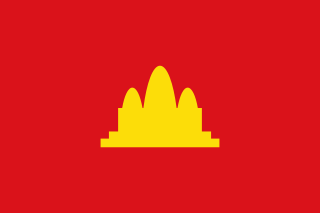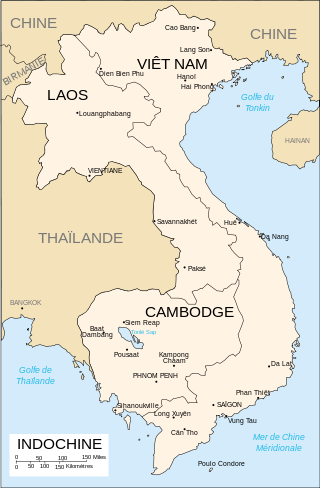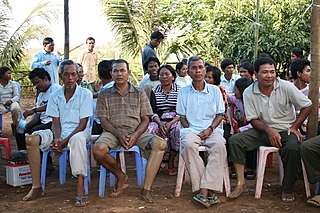
The Cambodian–Vietnamese War was an armed conflict between Democratic Kampuchea, controlled by Pol Pot's Khmer Rouge, and the Socialist Republic of Vietnam. The war began with repeated attacks by the Liberation Army of Kampuchea on the southwestern border of Vietnam, particularly the Ba Chúc massacre which resulted in the deaths of over 3,000 Vietnamese civilians. On 23 December 1978, 10 out of 19 divisions of Khmer Rouge's military divisions opened fire along the shared Southwestern borderline with Vietnam with the goal of invading the Vietnamese provinces of Đồng Tháp, An Giang and Kiên Giang. On 25 December 1978, Vietnam launched a full-scale invasion of Kampuchea, and subsequently occupied the country in 2 weeks and removed the government of the Communist Party of Kampuchea from power. In doing so, Vietnam put an ultimate stop to the Cambodian Genocide, during which 25% of the Cambodian population had already been executed under Pol Pot’s regime.

The Dângrêk Mountains, also the Dângrêk Range, is a mountain range forming a natural border between Cambodia and Thailand.

Preah Vihear Temple is an ancient Hindu temple built by the Khmer Empire, located on top of a 525-metre (1,722 ft) cliff in the Dângrêk Mountains, in the Preah Vihear province of Cambodia.

The Khmer National Armed Forces were the official armed defense forces of the Khmer Republic, a short-lived state that existed from 1970 to 1975, known today as Cambodia. The FANK was the successor of the Royal Khmer Armed Forces (FARK) which had been responsible for the defense of the previous Kingdom of Cambodia since its independence in 1953 from France.

Kampuchea, officially Democratic Kampuchea (DK) from 1976 onward, was the Cambodian state from 1975 to 1979, under the totalitarian dictatorship of Pol Pot and the Communist Party of Kampuchea (CPK), commonly known as the Khmer Rouge (KR). It was established following the Khmer Rouge's capture of the capital Phnom Penh, effectively ending the United States-backed Khmer Republic of Lon Nol. After Vietnam took Phnom Penh in 1979, it was disestablished in 1982 with the creation of the CGDK in its place.
Anlong Veng is a district (srok) in Oddar Meanchey province in Cambodia. The main town in the district is also called Anlong Veng. The population of the district could not be counted during the 1998 census of Cambodia due to ongoing conflict during the time of the census. It is estimated that 35% of the population in Anlong Veng were former Khmer Rouge soldiers.

The National Army of Democratic Kampuchea (NADK) was a Cambodian guerrilla force. NADK were the armed forces of the Party of Democratic Kampuchea also known as "Khmer Rouge", operating between 1979 and the late 1990s.
After the 1978 Vietnamese invasion of Cambodia and subsequent collapse of Democratic Kampuchea in 1979, the Khmer Rouge fled to the border regions of Thailand, and, with assistance from China, Pol Pot's troops managed to regroup and reorganize in forested and mountainous zones on the Thai-Cambodian border. During the 1980s and early 1990s Khmer Rouge forces operated from inside refugee camps in Thailand, in an attempt to de-stabilize the pro-Hanoi People's Republic of Kampuchea's government, which Thailand refused to recognise. Thailand and Vietnam faced off across the Thai-Cambodian border with frequent Vietnamese incursions and shellings into Thai territory throughout the 1980s in pursuit of Cambodian guerrillas who kept attacking Vietnamese occupation forces.
Sa Kaeo Refugee Camp was the first organized refugee relief camp established on the Thai-Cambodian border. It was built by the Royal Thai Government with support from international relief agencies including the United Nations. It opened in October 1979 and closed in early-July 1980. At its peak the population exceeded 30,000 refugees; no formal census was ever conducted.

Nong Chan Refugee Camp, in Nong Chan Village, Khok Sung District, Sa Kaeo Province, Thailand, was one of the earliest organized refugee camps on the Thai-Cambodian border, where thousands of Khmer refugees sought food and health care after fleeing the Cambodian-Vietnamese War. It was destroyed by the Vietnamese military in late 1984, after which its population was transferred to Site Two Refugee Camp.
The K5 Plan, K5 Belt or K5 Project, also known as the Bamboo Curtain, was an attempt between 1985 and 1989 by the government of the People's Republic of Kampuchea to seal Khmer Rouge guerrilla infiltration routes into Cambodia by means of trenches, wire fences, and minefields along virtually the entire Cambodia–Thailand border.

The Indochina refugee crisis was the large outflow of people from the former French colonies of Indochina, comprising the countries of Vietnam, Cambodia, and Laos, after communist governments were established in 1975. Over the next 25 years and out of a total Indochinese population in 1975 of 56 million, more than 3 million people would undertake the dangerous journey to become refugees in other countries of Southeast Asia, Hong Kong, or China. According to the United Nations High Commissioner for Refugees, 250,000 Vietnamese refugees had perished at sea by July 1986. More than 2.5 million Indochinese were resettled, mostly in North America, Australia, and Europe. More than 525,000 were repatriated, either voluntarily or involuntarily, mainly from Cambodia.

Bilateral relations between Cambodia and Thailand date to the 13th century during the Angkor Era. The Thai Ayutthaya Kingdom gradually displaced the declining Khmer Empire from the 14th century, importing much of its customs and culture. French protectorateship separated Cambodia from modern Thailand at the turn of the 19th–20th centuries, and diplomatic relations between the modern states were established on 19 December 1950.
The Cambodian humanitarian crisis from 1969 to 1993 consisted of a series of related events which resulted in the death, displacement, or resettlement abroad of millions of Cambodians.
The following lists events that happened during 2011 in Cambodia.

Prasat Ta Muen Thom or Prasat Ta Moan Thom is a Khmer temple located on Cambodian-Thai border.

The Cambodia–Thailand border is the international border between Cambodia and Thailand. The border is 817 km (508 mi) in length and runs from the tripoint with Laos in the north-east to the Gulf of Thailand in the south.

Mengly Jandy Quach is a Cambodian businessman and philanthropist, and founder of the Mengly J. Quach Education. He is also a survivor of the Cambodian genocide.

The battle of Pailin also known as the Siege of Pailin is an armed conflict which extended from 1989 to 1997 as the last military act of the Cambodian Civil War which took place in the Northwest of Cambodia in the last military stronghold of the Khmer Rouge.

The Cambodian Conflict or Khmer Rouge Insurgency, was an armed conflict that initiated in the Cambodian-Vietnamese War, Vietnam which provoked the deposition of Democratic Kampuchea, between the new Cambodian government and an anti-government coalition led by the Khmer Rouge.













